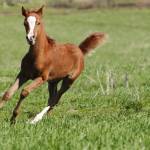Checking Roundworm Burdens in Foals with Ultrasound

Several chemical dewormers are showing less and less efficiency against a variety of equine internal parasites, including roundworms (Parascaris spp.). This leaves many equids at risk for developing parasite-related disease, such as colic, diarrhea, ill thrift, nasal discharge, poor coats, and slow growth.
Foals, weanlings, and yearlings appear particularly susceptible to high roundworm burdens, likely because they have little natural immunity against most disease-causing pathogens, parasites included. Foals are also susceptible to infection with the bacterium Rhodococcus equi,which causes pneumonia and abscesses in the lungs.
“Some farms on which R. equi is endemic routinely ultrasound foals’ chests in an attempt to diagnose and treat R. equi infections before the foals show clinical signs of disease. On such farms, large numbers of foals are already being examined with ultrasound technology, which made us wonder if ultrasonography could identify foals with heavy loads of roundworms,” explained Martin Nielsen, D.V.M., Ph.D., assistant professor at the University of Kentucky Gluck Equine Research Center.
Heavy parasite burdens put foals and young horses at risk for small intestinal impactions, and there is no test that can accurately identify foals that have large numbers of ascarids. Fecal egg count is currently used to diagnose internal parasites, but egg numbers do not necessarily correlate with the number of adult parasites.
Therefore, as described in detail in an unreleased study*, Nielsen and colleagues examined foals aged 162-294 days and determined that ultrasound could be used to identify roundworms in the small intestine.
“Ascarids appear as bright lines or circular structures in the small intestine, and sometimes had a ‘train track’ appearance, especially when the parasites are located in loops of small intestine that are lying close to the body wall and therefore closer to the ultrasound probe,” Nielsen described.
Nielsen and colleagues also found:
• The number of roundworms identified during the ultrasound examination correlated with the actual number of live ascarids and mirrored ascarid egg counts in manure;
• The “ascarid scoring system,” a scale ranging from 1 to 4, developed during this study was a valuable tool, especially when foals had parasite burdens of greater than 10 ascarids; and
• Veterinarians can quickly estimate the cost-to-benefit based on the chance of the foal suffering from a small intestinal impaction due to ascarids and the cost of the foal.
“This technique was originally developed with the assistance of Clara Fenger, D.V.M., who earned a doctorate in equine parasitology. Together, we found good intra- and interobserver agreement. This means that ultrasonography is a reliable screening tool for ascarids when performed by the same veterinarian on different days and even when a different veterinarian examines the same foal. The ease of implementing ultrasound screening for ascarids was further confirmed in early 2015 when we trained local veterinarians to use this technique,” emphasized Nielsen.
In sum, the research team concluded that their ultrasound screening technique is a feasible tool for equine veterinarians to help owners and farm managers make informed decisions regarding parasite control in young horses.
*Nielsen, M.K., E.M. Donoghue, M.L. Stephens, et al. An ultrasonographic scoring method for transabdominal monitoring of ascarid burdens in foals. Equine Veterinary Journal. In press.








